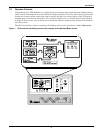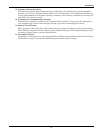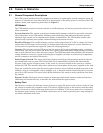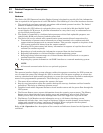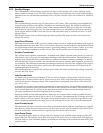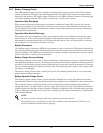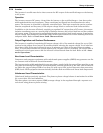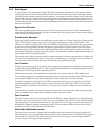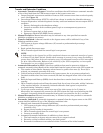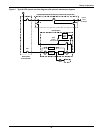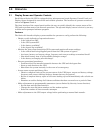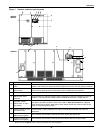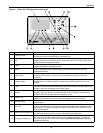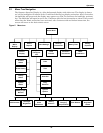
Theory of Operation
14
2.2.5 Static Bypass
A static bypass is an integral part of the UPS. The static bypass consists of a static bypass switch,
consisting of two reverse-paralleled SCRs (silicon-controlled rectifiers) per phase and bypass power
switching devices (motor-operated circuit breakers). An automatic transfer control circuit senses the
status of the operator controls, UPS logic signals and alarm messages and critical bus operating con-
ditions. If the inverter output can no longer supply the critical load, the static bypass switch (in con-
junction with motorized circuit breakers) automatically transfers the critical load to the bypass source
without interruption.
Bypass Circuit Breaker
The motor-operated bypass circuit breaker, wired in parallel with the static switch, automatically
closes within 200 milliseconds after the load is transferred to the bypass power source, removing the
static switch from the power flow.
Pulsed Parallel Operation
When an overload condition such as transformer inrush current or a branch load circuit fault exceeds
155% of the full-load current rating, the static bypass switch pulses on for 40 milliseconds. This
allows up to 1000% rated full load current (as limited by distribution feeders) from the bypass source
to clear the overload without closing the bypass circuit breaker (a Liebert design exclusive). The
bypass source is in parallel with the UPS system, permitting the bypass source to carry the initial
overload current. If the overload clears before 40 milliseconds, a load transfer to bypass is not made. If
the overload condition exceeds the inverter capacity, the automatic transfer is made (maintaining the
load voltage within the specified limits).
This pulsed static switch operation reduces nuisance operation of motor-operated circuit breakers for
such short-term conditions and serves, under some circumstances, as a backup in the event that an
external bypass feeder breaker trips open during this pulse-paralleling period.
Load Transfers
Transfers to (transfer) or from (retransfer) the bypass may be performed automatically or manually in
a make-before-break (MBB) sequence. This is accomplished through the overlapping operation of the
UPS output and the bypass power switching devices.
Manual load transfers and retransfers are initiated by the operator from the UPS control panel.
In a manual operation or an automatic retransfer, the two motorized circuit breakers UPS output and
system bypass (SBB) are both closed simultaneously for a short period of time (overlap).
Automatic transfers are initiated by the UPS system control logic when an overload is beyond the
specified capabilities of the UPS inverter or when a fault occurs within the UPS module. An auto-
matic retransfer is initiated if this function is enabled and if system conditions for a retransfer are
present.
In an automatic transfer, the circuit breakers do not overlap, but, during the short time gap, bypass
power is supplied to the critical load through the solid state static switch.
Fuse Protection
The static bypass switch path uses two back-to-back SCRs per phase. Each phase is individually pro-
tected by a fuse sized to clear only in the event of a catastrophic fault. This is a more reliable method
than depending on external protection devices. The fuses are in the circuit to protect the critical bus
distribution equipment against catastrophic faults. The static switch SCRs are oversized to easily
handle any current surges that may blow the fuses.
Static Switch Backfeed Protection
The static bypass system is equipped with redundant disconnect circuits that prevent backfeed of
lethal voltage to a de-energized bypass input in the event of a shorted static switch SCR. If the bypass
input power is interrupted, the static switch disconnect devices will open, preventing backfeed of
inverter voltage to the bypass input terminals.



